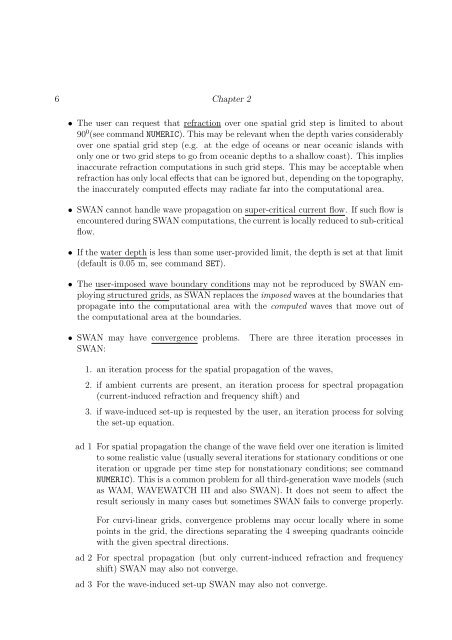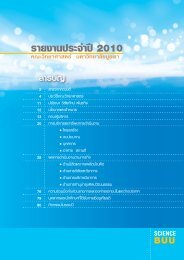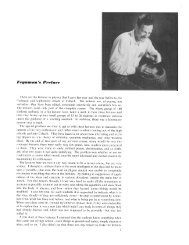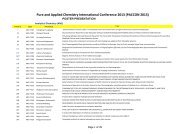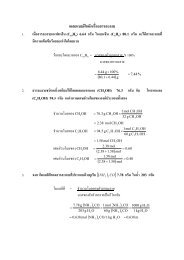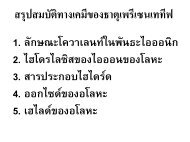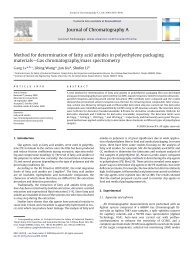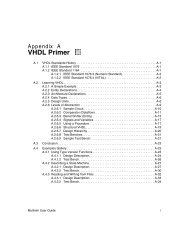USER MANUAL SWAN Cycle III version 40.72A
USER MANUAL SWAN Cycle III version 40.72A
USER MANUAL SWAN Cycle III version 40.72A
Create successful ePaper yourself
Turn your PDF publications into a flip-book with our unique Google optimized e-Paper software.
6 Chapter 2<br />
• The user can request that refraction over one spatial grid step is limited to about<br />
90 0 (see commandNUMERIC). This may be relevant when the depth varies considerably<br />
over one spatial grid step (e.g. at the edge of oceans or near oceanic islands with<br />
only one or two grid steps to go from oceanic depths to a shallow coast). This implies<br />
inaccurate refraction computations in such grid steps. This may be acceptable when<br />
refraction has only local effects that can be ignored but, depending on the topography,<br />
the inaccurately computed effects may radiate far into the computational area.<br />
• <strong>SWAN</strong> cannot handle wave propagation on super-critical current flow. If such flow is<br />
encountered during <strong>SWAN</strong> computations, the current is locally reduced to sub-critical<br />
flow.<br />
• If the water depth is less than some user-provided limit, the depth is set at that limit<br />
(default is 0.05 m, see command SET).<br />
• The user-imposed wave boundary conditions may not be reproduced by <strong>SWAN</strong> employing<br />
structured grids, as <strong>SWAN</strong> replaces the imposed waves at the boundaries that<br />
propagate into the computational area with the computed waves that move out of<br />
the computational area at the boundaries.<br />
• <strong>SWAN</strong> may have convergence problems.<br />
<strong>SWAN</strong>:<br />
There are three iteration processes in<br />
1. an iteration process for the spatial propagation of the waves,<br />
2. if ambient currents are present, an iteration process for spectral propagation<br />
(current-induced refraction and frequency shift) and<br />
3. if wave-induced set-up is requested by the user, an iteration process for solving<br />
the set-up equation.<br />
ad 1 For spatial propagation the change of the wave field over one iteration is limited<br />
to some realistic value (usually several iterations for stationary conditions or one<br />
iteration or upgrade per time step for nonstationary conditions; see command<br />
NUMERIC). This is a common problem for all third-generation wave models (such<br />
as WAM, WAVEWATCH <strong>III</strong> and also <strong>SWAN</strong>). It does not seem to affect the<br />
result seriously in many cases but sometimes <strong>SWAN</strong> fails to converge properly.<br />
For curvi-linear grids, convergence problems may occur locally where in some<br />
points in the grid, the directions separating the 4 sweeping quadrants coincide<br />
with the given spectral directions.<br />
ad 2 For spectral propagation (but only current-induced refraction and frequency<br />
shift) <strong>SWAN</strong> may also not converge.<br />
ad 3 For the wave-induced set-up <strong>SWAN</strong> may also not converge.


